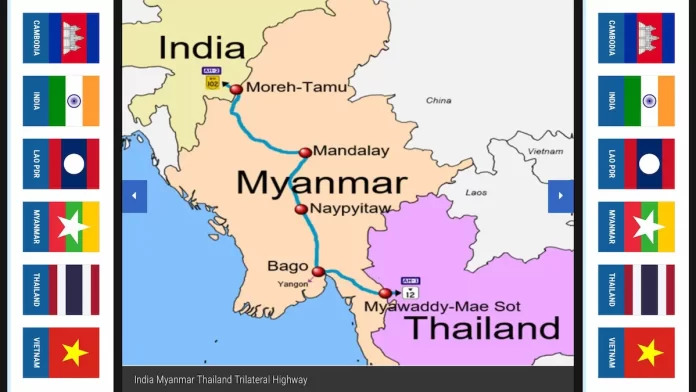Across the vast tapestry of Asia, two mighty rivers flow, nurturing vibrant cultures and economies: the Mekong in Southeast Asia and the Ganga in India. Their waters hold not just life, but the echoes of ancient connections, trade routes,and shared Buddhist heritage.
It is these very echoes that resonate within the Mekong-Ganga Cooperation (MGC), a unique initiative fostering closer ties between India and five Southeast Asian nations – Cambodia, Laos, Myanmar,Thailand, and Vietnam.
Weaving a Tale of Shared History
Born in 2000, the MGC predates many regional partnerships. Its foundation lies in the recognition of the profound historical and cultural linkages between the peoples of the Mekong and Ganga basins.
Centuries ago, Buddhist missionaries, traders, and scholars traversed these regions, leaving behind a legacy of shared artistic traditions, languages,and spiritual practices. The MGC seeks to revive these forgotten links, enriching the present and paving the way for a brighter future.
Blooming Blossoms of Collaboration
The MGC’s heart lies in four vibrant fields of cooperation:
- Tourism: Imagine Buddhist pilgrimages spanning the Mekong and Ganga, or eco-tourism trails weaving through lush jungles and snow-capped Himalayas. The MGC promotes tourism exchanges, showcasing each region’s unique tapestry of cultural heritage and natural wonders.
- Culture: The MGC’s cultural initiatives are a kaleidoscope of vibrant exchanges. From film festivals highlighting shared cinematic threads to archaeological collaborations unearthing ancient ties, these programs celebrate the diverse cultural expressions of the member nations.
- Education: Knowledge knows no borders, and the MGC champions educational exchanges. From student scholarships to faculty development programs, these initiatives foster closer academic ties, equipping future generations with the tools to navigate a shared future.
- Transport and Communications: Connectivity is the lifeblood of progress, and the MGC envisions a seamless network linking the Mekong and Ganga basins. Improved infrastructure, maritime cooperation, and technological advancements promise to boost trade, tourism, and overall economic development.
Harvesting the Fruits of Cooperation
Beyond fostering cultural understanding, the MGC aims to bring tangible benefits to its member nations. Some key achievements include:
- Boosting Trade: The MGC has facilitated trade missions and business linkages, leading to increased bilateral trade between India and the Mekong nations.
- Developing Skills: Capacity-building programs in areas like IT, agriculture, and disaster management have equipped countless individuals with valuable skills, empowering them to contribute to their economies.
- Sharing Knowledge: Collaborative research initiatives in fields like water management, renewable energy, and healthcare have led to innovative solutions shared across the region.
Navigating the Mekong-Ganga Riverboat
The MGC’s journey is not without its challenges. Complexities like language barriers, disparate levels of development,and geopolitical considerations require constant dialogue and flexible approaches. Nevertheless, the shared commitment to a brighter future fuels the MGC’s progress.
Looking Ahead: A River of Possibilities
As the world marches towards a more interconnected future, the MGC stands as a beacon of regional cooperation. It offers a model for sustainable development, cultural exchange, and economic prosperity for nations bound by ancient ties and modern aspirations. In the years to come, the MGC has the potential to:
- Become a Gateway to South Asia: The MGC can position Southeast Asia as a gateway for Indian investment and trade, while fostering deeper economic ties with South Asia.
- Champion Sustainable Development: Collaborative efforts in areas like renewable energy, water management,and infrastructure development can drive sustainable growth across the region.
- Nurture a Shared Future: By promoting cultural understanding and educational exchange, the MGC can create a generation of future leaders committed to regional cooperation and mutual prosperity.
Challenges and Navigating New Currents
Despite its promising journey, the MGC navigates a complex landscape. Internal differences in economic development, infrastructure, and political realities can pose hurdles to seamless cooperation. Additionally, language barriers and bureaucratic challenges can impede project implementation.
Furthermore, the burgeoning economic and political influence of China in the Mekong region presents both challenges and opportunities for the MGC. While China’s infrastructure investments and development projects offer potential partnerships, concerns regarding debt burdens, environmental impact, and regional dominance add a layer of complexity.
The MGC can navigate these challenges by emphasizing its unique strengths: its focus on cultural and historical ties, its emphasis on capacity building and knowledge sharing, and its flexible, non-hierarchical approach. By prioritizing shared regional prosperity over unilateral domination, the MGC can carve out a unique space for collaborative development in the region.
Furthermore, actively engaging with China, promoting transparency and sustainable infrastructure development, and collaborating on areas of mutual interest like environmental protection and disaster management can help the MGC foster a win-win scenario for all stakeholders in the Mekong basin.
By staying responsive to evolving regional dynamics and prioritizing the well-being of its member nations, the MGC can navigate the changing currents and emerge as a vital force for cooperation and progress in the Mekong-Ganga region.
The Mekong and the Ganga, once seen as distant rivers, now flow together in the spirit of the MGC. As this unique partnership continues to blossom, it promises to write a new chapter in the shared history of these vibrant civilizations,shaping a future where cultural treasures meet modern opportunities, and the waters of cooperation nourish a region rich in potential.
